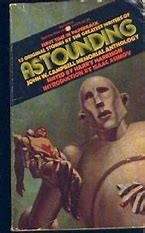In Poul Anderson's Technic History, there is faster than light interstellar travel (FTL) and many aliens whereas, in his much later single-volume future history, Genesis, there is slower than light interstellar travel (STL) and no aliens. The truth might be STL and some aliens.
Coya Conyon does not mind being alone among winged, feathered Ythrians, apart from her grandfather. Much later, her remote descendant, Tabitha Falkayn, grows up among Ythrians. I would welcome alien contact but would also find the close proximity of large partly bird-like bodies covered with feathers unsettling and unpleasant. Coya enjoys communicating with the Ythrians as we might see when I return from a walk along Lancaster Canal and the Lune River.

8 comments:
Well, my attitude to large feathered aliens would depend on my judgment of whether they were dangerous or not.
Sure. Many of us have irrational dislikes of other species.
Kaor, Paul and Mr. Stirling!
Paul: Circa 1959, the year HUNTERS OF THE SKY CAVE was pub., it was not known that planets orbited other stars, but the attitude some apparently held that there were no such planets doesn't make sense. It would be much more plausible to think it was very likely other stars had worlds of their own.
There's also Anderson's STARFARERS, which uses STL in a galaxy with many intelligent races. PA examines almost every possibility.
I hope I would not react with panic or terror to meeting non-humans. Albeit I doubt I would be as clever about it as Sean Francis Xavier in "Peek! I See You!"
Mr. Stirling: I agree! Humans will need to be cautious when first meeting extraterrestrials.
Happy New Year! Sean
Sean,
It was not initially plausible that most stars had planets. There was a theory of planetary origin that would have made them very rare.
Paul.
The two most commonly (only?) accepted hypotheses about the formation of planets were:
1) when a star forms from a cloud of gas and dust the collapsing cloud forms a central mass that turns into the star plus a disk of material revolving around the star that forms into multiple planets orbiting the star.
2) stars form without planets, but occasionally two stars have a near approach and material from the stars get pulled off, go into orbit around each star & condense into planets, while the stars move apart.
#2 implies planets are rare since stellar close approaches are rare.
#1 implies there are planets orbiting the vast majority of stars.
Evidence for #1 has become overwhelming over the last several decades.
Kaor, Paul and Jim!
Paul: Meaning you had in mind the second of the two theories summarized above by Jim. But, even granting that theory, I still find it difficult to understand why people could once believe ours was the only sun to have planets. Our galaxy has at least 100 billion stars, so, the nearer stars are to each other as you go nearer the center of the galaxy, more and more of those stars should have planets, due to being more likely to approach each other.
By the logic of that theory, it should be surprising Sol has any planets, due to being in the outer galaxy!
Jim: Exactly! Anderson seems to have believed the first theory was more plausible. And it allowed for more interesting SF stories.
Happy New Year! Sean
I did mean the second theory.
Kaor, Paul!
Which I remembered, after Jim summarized it. I think I read about that now abandoned theory in one of Asimov's books, way back in 1971.
Happy New Year! Sean
Post a Comment